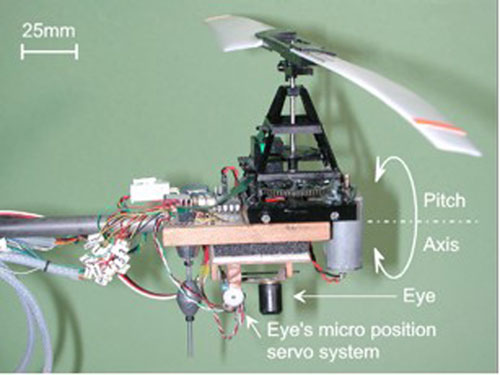Miniature Helicopter Packs Bug-Like Brain

As tiny as insect brains are, they can still perform extraordinary acrobatics in the air that human flying machines have yet to match. Now scientists reveal a miniature helicopter, with an electronic brain inspired by insects, that could help lead to better takeoffs, flights and landings for robotic aircraft.
Insects and other animals capable of powered, flapping flight are somehow able to execute controlled takeoffs and landings and keep flying at proper altitudes despite their lack of the sophisticated instruments available to human aviators.
"It's extraordinary to see flies navigate with just their small 10-milligram brains," said researcher Nicolas Franceschini, a neurophysiologist and engineer at France’s National Center for Scientific Research and at the University of the Mediterranean in France.
Bug brains
Franceschini and his colleagues have studied the insect brain for more than 30 years, during which time they have designed more than a dozen robots that drew on aspects of the insect nervous systems.
"They can do a lot with so little," Franceschini said.
The simple principles that Franceschini and his colleagues think underlie insect flight have to do with visual cues. As insects fly, their ground view changes depending upon their height above the ground and their speed relative to the ground. Essentially, the higher the insect, the slower the ground will appear to sweep below it.
Get the world’s most fascinating discoveries delivered straight to your inbox.
The changing view that insects have of the ground, known as "optic flow," thus encodes details on both an insect's height and velocity. Franceschini and his colleagues speculated that insects rely on simple relationships between their height and velocity to keep flying. Basically, the idea is that if they slow down, they will begin descent, and if they speed up, they will begin climbing. By the same token, if they are descending, they will slow down, and if they are climbing, they will speed up.
"They don't need a speedometer or altimeter. They just need to use their eyes," said Franceschini, whose latest work on this topic is detailed online in the Feb. 8 issue of the journal Current Biology.
And not very complex eyes at that. "Each compound eye of a housefly [image] only can see 3,000 pixels, nothing like the megapixels seen in today's digital cameras," Franceschini added.
Copying nature
The researchers developed a roughly 200-milligram electronic brain, or "optic flow regulator," that mimics what "the housefly just uses just two or three neurons to do," Franceschini said. They plugged the electronic brain into a three-ounce miniature helicopter, small enough to fit in a shoebox and equipped with a simple visual sensor pointed downward.
The helicopter was tethered to a rod and free to fly around a pole [image].
"It demonstrated very similar behavior to insects," Franceschini told LiveScience. "It never crashes. One could easily take an optic flow regulator and sensor and use it for aircraft to navigate autonomously."
Their findings also help illuminate the basis for a number of previously unexplained observations regarding insect flight. For instance, honeybees often drown when flying over very still water. "There are no contrasting features in their field of view then, so they have no visual cues to go by," Franceschini said. "Helicopter pilots have the same problem in the desert."



